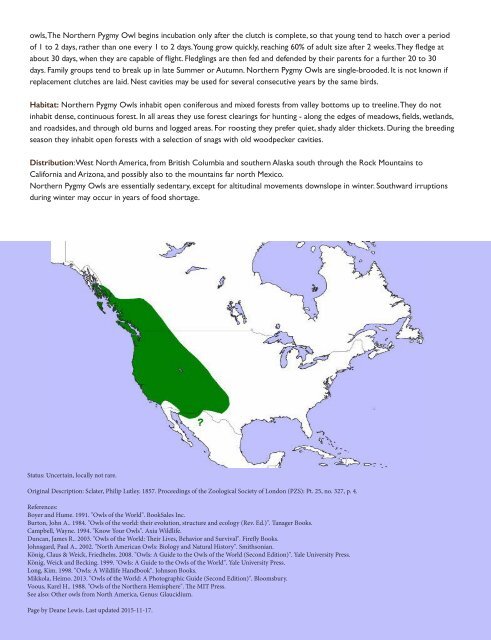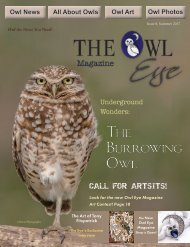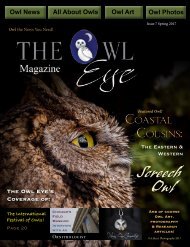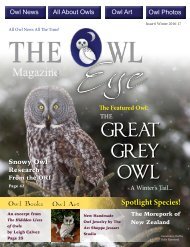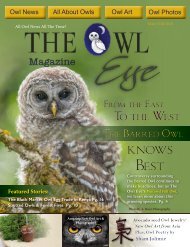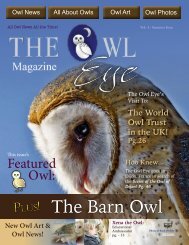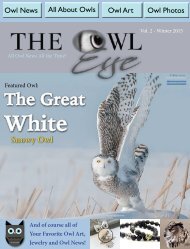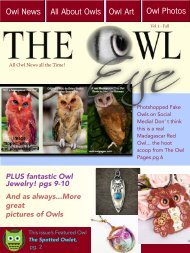The Owl Eye Magazine Issue 9
Create successful ePaper yourself
Turn your PDF publications into a flip-book with our unique Google optimized e-Paper software.
owls, <strong>The</strong> Northern Pygmy <strong>Owl</strong> begins incubation only after the clutch is complete, so that young tend to hatch over a period<br />
of 1 to 2 days, rather than one every 1 to 2 days. Young grow quickly, reaching 60% of adult size after 2 weeks. <strong>The</strong>y fledge at<br />
about 30 days, when they are capable of flight. Fledglings are then fed and defended by their parents for a further 20 to 30<br />
days. Family groups tend to break up in late Summer or Autumn. Northern Pygmy <strong>Owl</strong>s are single-brooded. It is not known if<br />
replacement clutches are laid. Nest cavities may be used for several consecutive years by the same birds.<br />
Habitat: Northern Pygmy <strong>Owl</strong>s inhabit open coniferous and mixed forests from valley bottoms up to treeline. <strong>The</strong>y do not<br />
inhabit dense, continuous forest. In all areas they use forest clearings for hunting - along the edges of meadows, fields, wetlands,<br />
and roadsides, and through old burns and logged areas. For roosting they prefer quiet, shady alder thickets. During the breeding<br />
season they inhabit open forests with a selection of snags with old woodpecker cavities.<br />
Distribution: West North America, from British Columbia and southern Alaska south through the Rock Mountains to<br />
California and Arizona, and possibly also to the mountains far north Mexico.<br />
Northern Pygmy <strong>Owl</strong>s are essentially sedentary, except for altitudinal movements downslope in winter. Southward irruptions<br />
during winter may occur in years of food shortage.<br />
Status: Uncertain, locally not rare.<br />
Original Description: Sclater, Philip Lutley. 1857. Proceedings of the Zoological Society of London (PZS): Pt. 25, no. 327, p. 4.<br />
References:<br />
Boyer and Hume. 1991. "<strong>Owl</strong>s of the World". BookSales Inc.<br />
Burton, John A.. 1984. "<strong>Owl</strong>s of the world: their evolution, structure and ecology (Rev. Ed.)". Tanager Books.<br />
Campbell, Wayne. 1994. "Know Your <strong>Owl</strong>s". Axia Wildlife.<br />
Duncan, James R.. 2003. "<strong>Owl</strong>s of the World: <strong>The</strong>ir Lives, Behavior and Survival". Firefly Books.<br />
Johnsgard, Paul A.. 2002. "North American <strong>Owl</strong>s: Biology and Natural History". Smithsonian.<br />
König, Claus & Weick, Friedhelm. 2008. "<strong>Owl</strong>s: A Guide to the <strong>Owl</strong>s of the World (Second Edition)". Yale University Press.<br />
König, Weick and Becking. 1999. "<strong>Owl</strong>s: A Guide to the <strong>Owl</strong>s of the World". Yale University Press.<br />
Long, Kim. 1998. "<strong>Owl</strong>s: A Wildlife Handbook". Johnson Books.<br />
Mikkola, Heimo. 2013. "<strong>Owl</strong>s of the World: A Photographic Guide (Second Edition)". Bloomsbury.<br />
Voous, Karel H.. 1988. "<strong>Owl</strong>s of the Northern Hemisphere". <strong>The</strong> MIT Press.<br />
See also: Other owls from North America, Genus: Glaucidium.<br />
Page by Deane Lewis. Last updated 2015-11-17.


